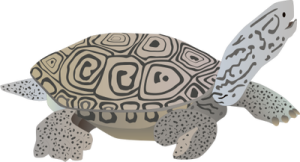- Each diamondback terrapin is a work of art. Their skin color ranges from pale to dark gray, or even black. The underside of their shell (plastron) ranges from yellow to green, or even black. But, those variations aren’t the reason for its name. If have the opportunity, be sure to check out the mesmerizing diamond-shaped growth rings on top of their shell (carapace).
 Diamondback terrapins are native to the eastern and southern United States (just like me)! They are distributed from Cape Cod, Massachusetts to Corpus Christi, Texas.
Diamondback terrapins are native to the eastern and southern United States (just like me)! They are distributed from Cape Cod, Massachusetts to Corpus Christi, Texas.- Diamondback terrapins have feet just like Ashton Kutcher. Their feet are robustly webbed, enabling them to be strong swimmers – which they need to be since they live in coastal areas with fluctuating tidal changes.
- There is only one terrapin native to the United States that lives exclusively in brackish saltwater marshes and bays … you guessed it, the Diamondback terrapin!
- Diamondback terrapins have a mid-life crisis at 20. They can live upwards to 40 years.
- Female diamondback terrapins are gladiators compared to the males. The shell of the females will reach up to 12 inches while the males typically reach 6 inches.
- Diamondback terrapins feast on meat. That’s right … they’ve only accidentally ingested vegetation (just like my 2yo). They prefer to dine on blue crabs, snails, mussels, clams, barnacles, or whatever else in common in their range. They are pretty industrious in their ability to crush shells with their uber strong upper and lower jaw.
- Female diamondback terrapins might live in the marsh, but they prefer to lay their nests (2 to 3 a year with up to 20 eggs a clutch) on the sand beach from May to July. This is why you’ll often see female terrapins tentatively crossing causeways linking mainland and barrier islands. Please drive the speed limit and slow down (stop!) for nesting female diamondback terrapins. This is the most important fact in this list.
- Diamondback terrapins take time to meditate. Ok, well, they remain dormant and slow their metabolism down when they hibernate during the winter by burrowing in the mud of the marshes.
- Female terrapins like it hot. A higher temperature of the nest produces more females.
- After hatching, young terrapins take their time adapting to life. Some remain in the nest during the winter although the majority enters the nearest body of water.
- Habitat loss, boat/car strikes, nest predation (1 to 3% of the eggs laid produce a hatchling), and crab pots are all threats of diamondback terrapins.
Resources/additional information:
http://www.vims.edu/research/units/programs/sea_turtle/va_sea_turtles/terps.php
http://www.aqua.org/explore/animals/diamondback-terrapin
http://www.defenders.org/diamondback-terrapin/basic-facts







What people are saying …